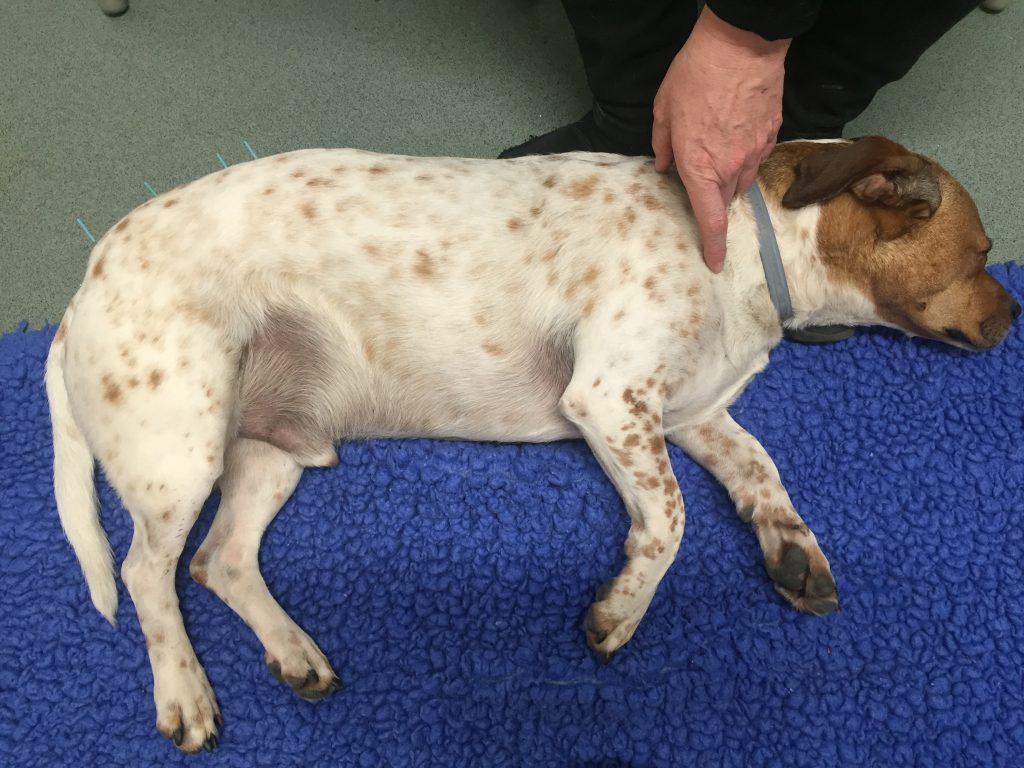Acupuncture and Pain Management
What is acupuncture?
Acupuncture is the practise of inserting fine, solid needles into the body for pain relief or, in some cases, to help the body deal with other diseases.
How does acupuncture work?
It works through the nervous system. The needles block the pain messages and encourage the brain and central nervous system to produce more of the body’s natural painkillers. In conditions that are not painful, acupuncture may help to reset the body’s normal functioning.
Will it hurt my pet?
Acupuncture needles stimulate nerves that do not cause the unpleasant feelings of pain that we’re trying to treat. They stimulate other nerves that send a more important message to the brain, which is how they block pain. Sometimes your pet may react to this sensation as though they’re expecting pain, but then relax because it doesn’t hurt. Most of the time they accept the fine needles very well and often become relaxed and sleepy during the treatment. Usually we find your pet enjoys their acupuncture treatment and will be looking forward to their next session!
Does my pet need to be sedated for this treatment?
Not usually. Sedation would only usually happen if a pet was particularly sensitive. And it might surprise you, but of all the animals we treat, cats and rabbits often accept acupuncture treatment very well.
How often would my pet be treated?
The usual course is once a week for four to six weeks. After four weeks we’ll be able to tell if the acupuncture is working for your pet and then, depending on the condition and how they’ve responded, we’ll work out a plan that usually involves tailing off the treatment so that the effect is maintained for as long as possible.
Is acupuncture safe?
Acupuncture is very safe. There have been no official reports of problems in animals, but there are some in humans and these can usually be avoided with care and a good knowledge of anatomy.
What kinds of conditions are treated with acupuncture?
Acupuncture is most commonly used to reduce pain. That can be pain associated with arthritis, but also muscle strains, pain secondary to disc disease and bony changes of the spine. Other kinds of pain may also respond.
Functional conditions such as constipation in cats and irritable bowel type problems in dogs may also respond.
What can I expect during treatment?
After examination, needles will be put into various parts of the body and moved or stimulated a few times. There is not a set “dose” of acupuncture as there is for medication, so your vet will judge how much to do based on your pet’s response both at the time and after the treatment.
And after the treatment?
When you get your furry friend home, you’ll probably find that they sleep very soundly for a long time – this is very common and a good sign! This shows that your pet will probably respond well to acupuncture. But don’t worry if they’re not sleepy, every pet reacts differently and this doesn’t mean that they won’t respond well. Sometimes your pet may seem a little more euphoric than usual; this is also a good sign, but try to keep them calm and relaxed for the rest of the day as they may overdo things.
Otherwise treat your pet normally after acupuncture. Do not change exercise, diet or medication unless we have discussed this with you.
What about response?
Your pet may show one of three responses to treatment:
- They may seem a little stiffer or more uncomfortable than usual. This just means that the dose was a little bit too much, but also shows that they should respond to treatment. After a day or two they’ll improve again and should be better than before. However, you must tell your therapist so that they can adjust the treatment next time.
- You may see no response. This is always disappointing but it doesn’t mean that your pet will not respond; they may just take a little longer to respond or their improvement after their first treatment was too brief or small for you to see. We can’t say whether they’ll respond or not until after the fourth treatment. Not all animals are acupuncture “responders”, but about 80% will be.
- You may see an improvement. This may occur anytime in the three days after their treatment. The signs that we’re trying to treat may then return before the next treatment, but this is fine. After each subsequent treatment the effects should last for longer, so that eventually your pet may not need any more treatments for some time.


